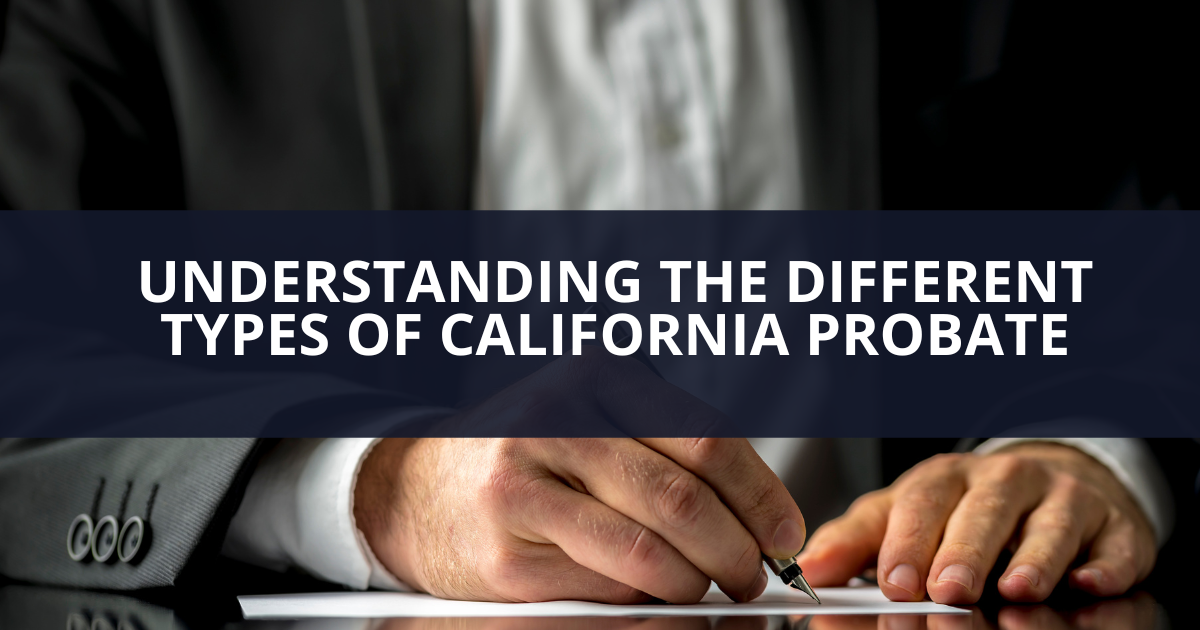Confused about the different types of California probate?
When someone passes away in California, their estate can be transferred through various probate routes, each designed to fit the estate’s value and complexity. Whether it’s a full court-supervised probate, a streamlined summary process, or a simple small estate affidavit, these methods aim to make asset distribution more efficient, less costly, and quicker. This guide will walk you through:
- The main types of probate and who qualifies
- The steps, players, timeline, and costs involved in formal probate
- What’s needed for summary probate and its pros and cons
- The limits and process for using a small estate affidavit
- Alternatives to probate, like trusts and joint ownership
- How to determine your estate’s value and what assets don’t count
- The overall probate process and the key people involved
- Smart ways to avoid probate altogether through estate planning
What Are the Main Types of Probate in California?
California probate offers three primary avenues for transferring assets after death: formal probate, summary probate, and the small estate affidavit. These options are tailored to different estate values and complexities, ensuring assets are distributed orderly, with appropriate legal oversight, and with less court involvement for smaller estates.
What Is Formal Probate and When Is It Required?
Formal probate is the court-supervised process where an executor or administrator is appointed, assets are inventoried, debts are settled, and the court gives the final go-ahead before property can be distributed. This is typically required for larger or more complicated estates, or when there are disputes, to ensure legal protections for everyone involved and to satisfy creditors.
How Does Summary Probate Work in California?
Summary probate, also called summary administration, is a quicker process for estates that fall between the small estate limits and the full probate threshold. It involves simpler paperwork, less court oversight, and a faster timeline for distributing assets without all the extensive procedures of formal probate.
What Is a Small Estate Affidavit and Who Can Use It?
A small estate affidavit is a way to collect personal or real property valued below certain legal limits without going through formal probate court. Anyone who is legally entitled to receive assets and whose inheritance falls within these statutory limits can use this method for a more affordable and faster transfer.
How Do Probate Types Differ in Eligibility and Process?
Here’s a quick look at California’s probate options, showing who qualifies, how long they typically take, and their main advantage.
Probate Process | Estate Value Threshold | Typical Duration | Primary Benefit |
|---|---|---|---|
Formal Probate | Over $184,500 (personal property & real estate) | 9–18 months+ | Full creditor protection and oversight |
Summary Probate | $166,250–$184,500 (personal property only) | 3–6 months | Reduced court involvement and fees |
Small Estate Affidavit | Up to $184,500 for personal property; up to $61,500 for a residence (as of 2024) | 40–60 days (after death) | No court hearing or formal administration needed |
Each method balances legal requirements with procedural ease to speed up asset distribution. Let’s dive deeper into formal probate next.
California Probate Code – Overview
The California Probate Code lays out the legal rules for managing estates, covering formal probate, summary probate, and small estate procedures. It details what’s required for each, including who qualifies, the timelines, and how assets are valued.
California Probate Code, Sections 13000-13660 (2024)
How Does the Formal Probate Process Work in California?
Formal probate in California is a structured, court-supervised process that ensures debts are paid, and assets are distributed in accordance with the law. It promotes accountability, transparent financial reporting, and creditor protection.
What Are the Key Steps in Formal Probate Administration?
The formal probate process involves several distinct stages to ensure proper oversight and asset management:
- Filing the Petition for Probate The process begins when someone files Form DE-111 with the probate court to officially open the estate and ask for a personal representative to be appointed.
- Appointment of Personal Representative The court issues Letters Testamentary or Letters of Administration, officially granting the executor or administrator the authority to act for the estate.
- Notifying Heirs and Creditors Legal notices are published, and known heirs and creditors are directly informed, starting a period for them to submit claims against the estate.
- Inventory and Appraisal of Estate Assets The personal representative creates a detailed list of all estate assets and arranges for a probate referee to determine their value.
- Paying Debts, Taxes, and Expenses Before any assets are distributed, all valid debts, taxes, and administrative costs must be paid from the estate.
- Distribution of Remaining Assets: Once all claims are settled, the court reviews and approves the plan for distributing the remaining assets to beneficiaries, either as directed by the will or under state law if there’s no will.
- Closing the Estate: A final accounting is submitted to the court, and once all duties are completed, the court formally closes the estate and releases the personal representative.
These steps ensure fairness and legal compliance, setting the stage for understanding the key players involved.
California Courts – Probate Information
The official website for the California Courts offers comprehensive details on probate procedures, including necessary forms, helpful guides, and resources for those navigating the probate process. You can find information on the roles of the executor and the court, as well as the steps involved in managing an estate.
Judicial Council of California, California Courts (2024)
What Roles Do the Executor and Probate Court Play?
The executor (or administrator) and the probate court work together to manage the estate effectively:
- Executor is responsible for gathering assets, settling debts, and distributing property under the court’s supervision.
- Probate Court reviews all filings, resolves any disagreements, and issues orders to ensure the process adheres to probate laws.
How Long Does Formal Probate Take and What Are the Costs?
The time and cost of formal probate can vary depending on how complex the estate is. Here are some typical timelines and expenses:
Component | Duration | Cost |
|---|---|---|
Court Proceedings | 9–18 months | Statutory fees based on estate value (1–4%) |
Attorney and Accountant Fees | 9–18 months+ | Varies based on hourly rates or a percentage of the estate value |
Appraisal and Publication | 1–3 months | Fees for appraisals and newspaper notices |
Knowing these estimates can help families plan their finances and timelines, making informed decisions about their probate strategy.
When Is Formal Probate Mandatory Based on Estate Value?
California law requires formal probate if the gross value of the estate’s personal and real property exceeds $184,500, and it doesn’t qualify for simplified procedures. For estates with complicated assets, potential disputes, or creditor issues, formal probate provides the necessary legal protections for proper administration.
What Are the Eligibility Requirements and Procedures for Summary Probate?
Summary probate simplifies the administrative process for moderately valued estates by reducing court steps and paperwork. This faster route can lead to quicker asset distribution and lower costs for eligible estates.
What Estate Values Qualify for Summary Probate in California?
Summary probate is an option when the decedent’s personal property (not including real estate) is valued between $166,250 and $184,500, as of April 1, 2025. Estates within this range can benefit from a more streamlined court process.
How Is Summary Probate Filed and Processed?
- File a petition for summary distribution with the probate court.
- Submit an affidavit confirming the petition and a notice of the hearing.
- Provide proof that heirs and creditors have been notified.
- Attend a brief court hearing if the judge requires it.
- Receive an order for summary distribution from the court.
This condensed process helps close the estate more quickly and facilitates prompt asset transfers.
What Are the Benefits and Limitations of Summary Probate?
Summary probate offers distinct advantages and some drawbacks:
- Benefits
- Faster resolution and lower court fees
- Less paperwork and fewer required filings
- Potentially less attorney involvement
- Limitations
- Generally applies only to personal property, not real estate
- Heirs must agree on the terms of the affidavit
- Creditors have a shorter timeframe to file claims
By considering these points, heirs can determine if summary probate is the most efficient path for their mid-range estate.

How to Use a Small Estate Affidavit in California Probate?
A small estate affidavit is the most straightforward way to claim assets below certain legal limits without needing court administration. This method allows for low-cost, quick transfers for estates that qualify.
What Are the Current Small Estate Limits and Thresholds for 2025?
As of April 1, 2025, California’s small estate limits are:
- Up to $208,850 for personal property (like bank accounts, vehicles, and personal belongings)
- Up to $750,000 for a primary residence using a simplified affidavit process for real property
These updated limits make it easier for families with modest estates to access and transfer property more quickly.
How to File a Small Estate Affidavit for Personal Property?
- Complete the small estate affidavit form (as outlined in Probate Code § 13100).
- Include a certified copy of the death certificate.
- Provide a detailed list of the personal property being transferred.
- Have the affidavit officially notarized.
- Submit the affidavit to the financial institutions or entities holding the assets.
This process speeds up access to funds and personal items without the need for court petitions.
Can a Small Estate Affidavit Be Used for Real Property?
Yes, for deaths occurring on or after April 1, 2025, a small estate affidavit can be used to transfer a primary residence valued up to $750,000 without going through full probate. This specific provision simplifies the transfer of real estate for eligible heirs.
What Is the Waiting Period and Required Documentation?
Heirs must wait at least 40 days after the decedent’s death before they can file the affidavit. The necessary documents include:
- A certified copy of the death certificate
- The notarized small estate affidavit form
- A detailed inventory and appraisal, if requested
Adhering to this waiting period ensures compliance with legal timelines and creditor notification rules.
What Are the Alternatives to Probate in California?
Non-probate methods allow assets to be transferred outside of court supervision, offering faster, more private, and cost-effective solutions. These strategies are key to effective succession planning.
How Do Living Trusts Help Avoid Probate?
A living trust holds assets in the trust’s name, not the decedent’s, allowing the trustee to distribute them immediately upon death according to the trust’s terms. This approach enhances privacy, reduces delays, and bypasses court oversight for assets held in the trust.
What Role Do Joint Tenancy and Right of Survivorship Play?
When property is held in joint tenancy with a right of survivorship, ownership automatically transfers to the surviving co-owner upon the death of one owner, bypassing probate. This is a simple way to transfer jointly owned assets.
How Do Payable-on-Death (POD) and Transfer-on-Death (TOD) Accounts Work?
Accounts designated as Payable-on-Death (POD) or Transfer-on-Death (TOD) allow named beneficiaries to claim the funds directly upon presenting proof of death, completely avoiding probate and providing quick access to liquid assets.
What Are Spousal Property Petitions and Heggstad Petitions?
A spousal property petition allows a surviving spouse to transfer community property or jointly owned assets without probate. A Heggstad petition can be used to transfer certain real property interests that were mistakenly titled in the decedent’s name, avoiding formal probate proceedings.
How Are California Probate Thresholds and Limits Determined?
Probate eligibility thresholds are periodically updated for inflation and legislative changes, defining which probate pathway or small estate option is applicable.
What Are the Current and Upcoming Probate Value Limits?
As of April 1, 2025:
- Small estate affidavit limit for personal property: $208,850
- Limit for non-court transfer of real property: $750,000
- Summary probate range: $166,250–$184,500
These limits are adjusted biennially to account for inflation and changes in the housing market.
How Is Estate Value Calculated for Probate Purposes?
To determine the estate’s value for probate, you need to:
- Add up the fair market value of all personal and real property owned by the decedent.
- Subtract any outstanding funeral expenses and secured debts (like mortgages).
- Exclude assets that pass outside of probate, such as IRAs or life insurance policies with named beneficiaries.
Accurate valuation is crucial for selecting the correct probate process.
Which Assets Are Excluded from Probate Calculations?
Assets that typically bypass probate include:
- Life insurance proceeds paid directly to named beneficiaries
- Retirement accounts (like 401(k)s and IRAs) with designated beneficiaries
- Assets held within a living trust
- Property owned in joint tenancy with a right of survivorship
Understanding these exclusions helps reduce the portion of the estate subject to probate.
What Is the Overall California Probate Process and Key Roles?
California’s probate system involves several parties—personal representatives, courts, creditors, and beneficiaries—working together to ensure assets are transferred legally.
What Are the Steps of Probate Administration in California?
The general steps in probate administration are:
- Initiating the probate process by filing a court petition
- Appointing a personal representative
- Creating an inventory and appraisal of all assets
- Notifying creditors and resolving their claims
- Paying all debts, taxes, and administrative expenses
- Distributing the remaining assets to beneficiaries
- Submitting a final accounting and obtaining the court’s discharge of the representative
This structured process establishes clear fiduciary duties and ensures creditors are protected.
What Responsibilities Do Executors and Administrators Have?
Executors and administrators are responsible for:
- Safeguarding and managing all estate assets
- Notifying heirs, beneficiaries, and creditors
- Filing necessary inventories, accountings, and tax returns
- Promptly paying all valid claims, taxes, and expenses
- Distributing assets according to the will or state law
These duties are essential for maintaining integrity and compliance throughout the administration.
How Does the Probate Court Oversee the Process?
The probate court reviews petitions, approves asset inventories, resolves disputes, and issues official orders at critical stages. This judicial oversight prevents mismanagement and ensures all legal standards are met.
How Are Creditor Claims Handled During Probate?
Creditors must submit their claims within a specific timeframe after being notified. The personal representative reviews these claims, pays valid ones using estate assets, or challenges invalid claims in court. This process balances the rights of heirs with the claims of creditors.
FAQ's- Types of Probate in California
California offers three primary probate options: formal probate (for larger or complex estates), summary probate (for mid-range estates with less court involvement), and the small estate affidavit (for quick transfers of modest estates).
Formal probate is required when the estate’s total value exceeds $184,500 (personal and real property combined) or when there are disputes, complicated assets, or creditor issues that need court oversight.
Formal probate generally lasts 9 to 18 months or longer, depending on the size of the estate, whether there are disputes, and how quickly documents are filed and approved.
Summary probate is a simplified process for estates where personal property (not including real estate) is valued between $166,250 and $184,500. It allows quicker resolution with reduced court involvement.
Heirs can use a small estate affidavit to claim property when the estate is valued under California’s legal limits (as of April 1, 2025: $208,850 for personal property and $750,000 for a primary residence). The affidavit must be notarized, accompanied by a death certificate, and submitted to the institutions holding the assets.
There is a 40-day waiting period after the date of death before a small estate affidavit can be filed. This ensures time for creditor claims and proper processing.
Yes. For deaths on or after April 1, 2025, a simplified affidavit process can transfer a primary residence valued up to $750,000 without requiring full probate.
Certain assets may pass outside of probate, including life insurance policies with named beneficiaries, retirement accounts (IRAs, 401(k)s), assets held in a living trust, and property owned in joint tenancy with right of survivorship.
Avoiding probate can mean faster distribution of assets, lower costs, greater privacy, and reduced court involvement. Tools like living trusts, joint tenancy, and payable-on-death accounts help achieve this.
The right probate process depends on the estate’s value, types of assets, creditor situation, and family dynamics. Consulting a probate attorney can help families determine whether formal probate, summary probate, or a small estate affidavit best fits their needs.
How Can You Avoid Probate in California?
Using effective estate planning tools and non-probate transfer methods can significantly reduce or eliminate the need for probate, saving both time and money.
What Strategies Are Effective for Bypassing Probate?
Key strategies for avoiding probate include:
- Setting up a revocable living trust for your major assets
- Owning property in joint tenancy with a right of survivorship
- Utilizing beneficiary designations on accounts (POD/TOD and retirement funds)
- Filing small estate affidavits for assets that qualify
Implementing these methods can streamline how your assets are passed on and minimize court involvement.
What Are the Advantages of Non-Probate Transfers?
Non-probate transfers offer several benefits:
- Increased privacy, as court records are not made public
- Faster distribution of assets without lengthy waiting periods
- Reduced legal and administrative fees
- Greater control over when and how assets are transferred
These advantages contribute to a more predictable and efficient estate settlement.
How Does Estate Planning Help Minimize Probate?
Comprehensive estate planning, which includes wills, trusts, and beneficiary designations, aligns how your assets are titled with your personal wishes. It can also minimize tax liabilities and ensure your heirs receive property directly, effectively bypassing formal probate.
Navigating probate in California offers flexible options tailored to the estate’s size, asset types, and family circumstances. By understanding formal probate, summary administration, small estate affidavits, and non-probate alternatives, you can streamline the process, cut expenses, and ensure a smoother transfer of assets. Careful planning and timely action empower you to handle probate with confidence, preserve family wealth, and honor the decedent’s final wishes.






